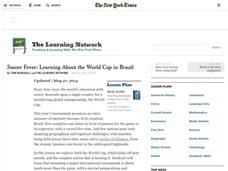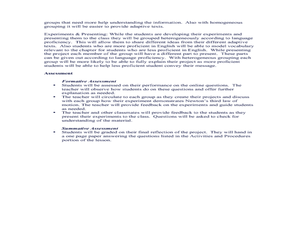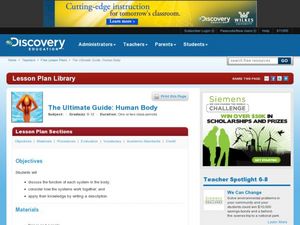The New York Times
Soccer Fever: Learning About the World Cup in Brazil
What an incredible collection of ideas for teaching about the 2014 World Cup in Brazil! This resource is packed with news articles and instructional activities on a wide variety of topics, from the global popularity of soccer and the...
Curated OER
Anatomy of a Kick
Students investigate the muscle system operating in the kick of a ball. The order in which the six muscle groups contract is noted as the movement is produced by the contraction of opposing muscles required to move a limb in opposing...
Curated OER
Sports and Science
Using footballs, basketballs, tennis balls, and more, learners conduct experiments to illustrate Newton's Laws of Motion. The experiments are conducted outside, and require them to throw, kick, and hit a variety of balls. Your...
Curated OER
Being Forceful
Young scientists consider the forces of push and pull, start and stop, and try to categorize each one correctly. There are five cartoon drawings of kids performing an activity. Learners must write push or pull, and start or stop in the...
Curated OER
Isaac Newton's Third Law of Motion
Ninth graders experiment with Isaac Newton's Third Law of Motion. In this Third Law of Motion lesson, 9th graders develop an experiment that shows their understanding of this theorem. They work in small groups to read an article at a...
Curated OER
What is Energy?
In this energy activity, learners will determine if 7 examples represent kinetic energy or potential energy. Then students will study an illustration of a child coming down a slide and answer 5 energy questions based on the illustration.
K12 Reader
Converting Energy to Motion
Combine science and reading skills with a reading comprehension exercise. Kids read four paragraphs about energy conversion and answer some reading comprehension questions about the information they have read.
Curated OER
The Ultimate Guide: Human Body
Students study the body systems and their functions. In this human body lesson students research the Internet on body systems and write a description of them.
Curated OER
Calculating Speed
In this speed worksheet, students calculate the average speed of an object or the distance an object travels at a certain speed in 11 word problems.
Physics Aviary
Physics Aviary: Ground to Ground Soccer Kick Lab
This lab is designed to have students find the relationships that govern the behavior of a soccer ball that is kicked on an angle. The ball will start on the ground and end on the ground. Students will have control over the speed of the...
Physics Aviary
Physics Aviary: Practice Problems: Finding Velocity in a Ground Soccer Kick
Students must determine where a soccer ball will land based on the speed with which it is kicked. Students will also need to find the time in the air and the maximum height obtained by the projectile. This problem does not take place on...
Physics Aviary
Physics Aviary: Practice Problems: Ground to Wall Soccer Kick Problem
Students must determine where a soccer ball will hit a wall based on the speed with which it is kicked. Students will also need to find the time in the air in milliseconds. This problem does not take place on Earth.
Physics Aviary
Physics Aviary: Practice Problems: Ground to Ground Soccer Kick Problem
Students must determine where a soccer ball will land based on the speed with which it is kicked. Students will also need to find the time in the air and the maximum height obtained by the projectile. This problem does not take place on...
Physics Aviary
Physics Aviary: Practice Problems: Corner Kick
Students must determine the 3 components of the initial velocity of a soccer ball on a corner kick. Students will see the displacement of the ball in all three dimensions as well as the time the ball is in the air. Students must also...
Physics Aviary
Physics Aviary: Practice Problems: Arriving at a Certain Height Problem
Students must determine when a soccer ball reaches a given height based on the velocity with which it is kicked. Students are reminded that the ball will reach this height twice, once on the way up and once on the way down. Students must...









